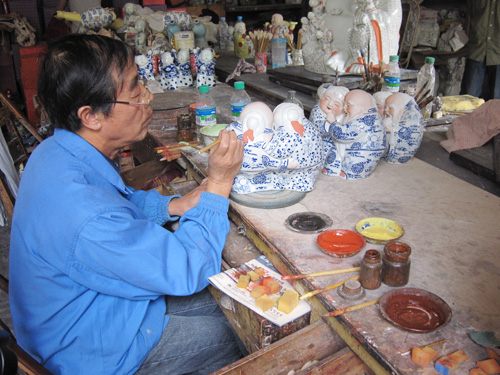|
 |
|
DETAIL MATTERS: A ceramics artisan paints a piece of porcelain (ZHENG YANG) |
"It's like tracing porcelain back to its origin," said Chris Dagradi at the Jingdezhen International Ceramics Fair held on October 18-22, the largest event of its kind in the world. Jingdezhen, known as "China's porcelain capital," has a porcelain-making history of over 1,700 years.
Dagradi attended the fair as a representative of Deft, a Dutch city also known for its ceramic products styled on Chinese porcelain imported during the 17th century.
"Four hundred years ago, the Dutch came to China to buy beautiful porcelain pieces, and then we began to imitate them in Holland," he said. But after the 17th century, there was no contact between Deft and Jingdezhen.
"Now we are coming back," he said. Based on an inter-city cooperation agreement, Deft wants to renew its historical relationship with Jingdezhen through several exchange programs.
But not only the Dutch are interested in Jingdezhen. Every year the "porcelain capital" of China is host to millions of Chinese and foreign visitors trying to unravel the mysteries of this ancient industry's past, and share its promising future.
For those unfamiliar with Jingdezhen in east China's Jiangxi Province, the city's former name, Changnan, may ring some bells. In the 17th century, Changnan exported ceramic products that were highly coveted by upper-class Europeans. Having difficulty pronouncing the city's original name, they called it "china," and referred to its exquisite porcelain products using the same name. In the following centuries, these delicate pieces formed Westerners' first, vague impressions of China, the remote dragon nation of the East.
To date, modern industries like aerospace and vehicle production have replaced the traditional ceramic business to become the pillars of the city's economy. But the city's pride in its splendid history can still be seen in ceramic-decorated streetlights and trash cans on the streets and bridges with names that evoke the city's connection to ceramics.
To celebrate Jingdezhen's traditions, an ancient kiln was lit in a ceremony conducted during the October fair. The dragon-shaped kiln was built by porcelain archaeologists and scholars in the style of the Dragon Kiln of the Song Dynasty (960-1279). The ceremony followed a complicated traditional ritual, including a sacrifice to the god of ceramics. According to legend, the god was originally a human who died in the process of doing the impossible: creating a perfect work.
"Young people nowadays know little about tradition," said Yang Peng, director at Jingdezhen Ceramic Corp., a modern tech-based enterprise. She believes that the ceremony was aimed at reminding people to have a scrupulous and serious attitude toward work. "We inherited porcelain-making techniques from our ancestors. These actions show our determination to pass our tradition and spirit on to the next generation."
In recent years, reconstructions of porcelain kilns used during the Yuan, Ming and Qing dynasties have been lit. These events are designed to echo the slogan, "keeping the kiln fire burning for thousands of years," and are part of the city's efforts to revive historic porcelain-making techniques.
In the Ancient Kiln Folk-custom Exhibition Zone where replicas of the ancient kilns are on display, many masters of hand-making porcelain show their skills. Most of them are over 60, but younger artists can also be found. The loss of cultural heritage in other cities has been a cause for concern, but young people in Jingdezhen may revive the city's tradition in porcelain-making and popularize it across the country.
As part of the sacrificial ritual to the god of ceramics, Liu Changlin, Mayor of Jingdezhen, read a traditional ritual verse in front of an actor who played a "ceramic god" dressed in the traditional costume of the Qing Dynasty (1644-1911). Part of the ritual involved two guests taking turns paying their respects to the god by making an offering of wine. After them, American artist Philip Read took part in the ceremony.
| 